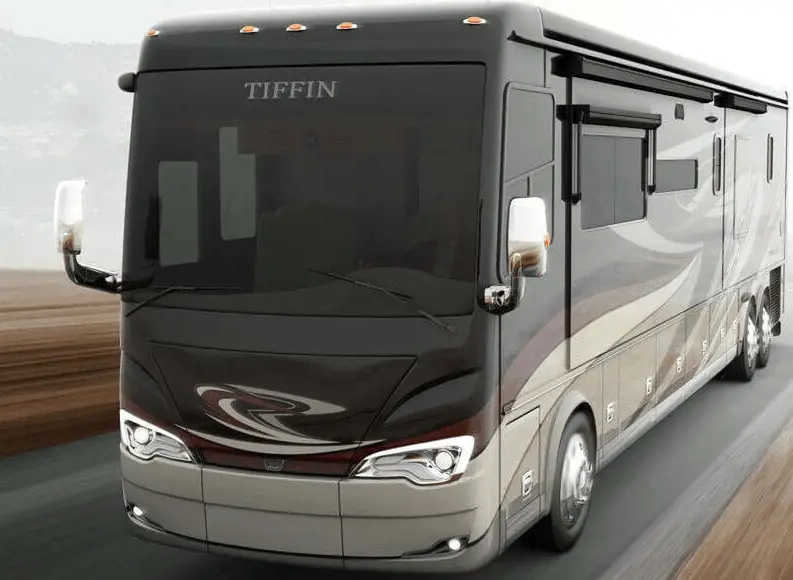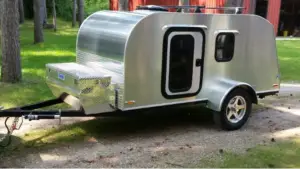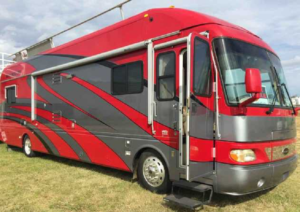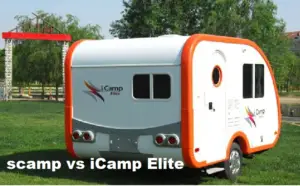There are a variety of options when it comes to choosing a motorhome that fit travelling style and individual specific outdoor desires.
Many people find themselves indecisive on whether to choose the Class A, B, or C motorhomes.
The huge lavish panoramic windows and the vast space are some of the features that leave many travelers stuck with the class A motorhome option.
This article explores some reasons that may make you reconsider buying a Class A and try other available models such as Class B or C motorhomes.
1. Would require Tow Vehicle if One Wants to Get Around
Finding a parking for a Class A motorhome can be tedious and frustrating. They are too long, 29-45 feet to allow easy explorations of recreational places within towns and cities.
Their sheer length makes them require a powerful towing vehicle. Even those that do not need towing can feel unstable on curved terrains. Also having two engines implies you have to budget for twice the fuel, twice the maintenance, and twice the repairs.
Only certain types of vehicles can be towed behind a Class A recreational vehicle (RV). For example, you may need a rear-wheel-drive car with a manual transmission or a four-wheel-drive vehicle with a manual transfer case put in neutral.
Such special requirements limit the type of tow vehicles that you can own. Also, since it is not possible to drive two vehicles simultaneously, you will be required to drive with your friends or spouses separately behind them.
2. More Expensive to Purchase than Towable
Before you start considering investing in a Class A motorhome, you should have in mind that Class A RVs come with a hefty price tag.
They are designed for luxurious adventures, so price can be quite high. In fact, most of them cost more than sticks and brick houses. The average cost of a Class A RV ranges from $75000 on the low end to $3 million or more on the high end.
Even used Class A motorhomes can leave someone with a high loan payment. It could be a regrettable decision to take up a loan to buy a Class A motorhome if you lack the necessary investment budget.
3. High Maintenance and Repair Costs
Besides expensive upfront cost associated with Class A motorhomes, they are expensive to maintain and repair.
Think about all the luxurious accessories found inside! Maintaining the luxury and style to keep it lavish appearance requires a fortune.
Furthermore, you must incur the fuel cost and believe me Class A is a fuel guzzler, 7-13 average miles/gallon compared to Class B, 18-25 average miles/gallon.
Class A RVs engines need a lot to maintain and repair. Their engines are complex pieces of machinery compared to those found in normal vehicles.
If their engine goes off, their repair options might be limited to the closest shop, which could be pricey, assuming that you are even lucky enough to find a repair shop for the motorhomes on the road. Furthermore, their sizes make it difficult and very expensive to tow.
If Class A develops a mechanical issue, one would be required to find a hotel to spend until it is fixed. This may be inconveniencing for those making weekend trips.
4. Major Depreciation
Class A motorhomes are seldom a good investment because they are very expensive but experience an initial shot of depreciation immediately after the new owner drives them out of the dealer’s lot.
In fact, NADA Guides suggest that the price of Class A motorhomes depreciate by 25% immediately upon purchase.
In the event of an accident, a big insurance bill and a high cost to replace the RV follows. Despite any upgrades made on a Class A RV involved in an accident, its value depreciates quickly, even if the accident was minor.
Bigger Class A RVs take even more of a hit by depreciating faster than smaller ones over time.
5. Engine and Living Area Combined – Means Less space
Combining the engine and living area into the same footprint means that someone will naturally have less space. Even if someone uses a diesel pusher whereby the engine is in the back, the cab area will still eat up a noticeable portion of the living space. This feature is a downside for most people.
If the engine needs to go to the shop for repairs, people living in Class A RVs full-time risk having no RV for days. The same pinch is felt by those looking to spend their weekend camping.
Having an engine and the living room together can be inconvenient to someone who needs to get some work done due to the constant disturbing noise produced by the running engine.
Space is already at a premium for anyone travelling in an RV. Having unusable square footage naturally becomes a significant con. More seriously, any significant issue with the engine, such as a fire, will occur right in the living space.
Front engine Class A RV models have more of their living space depleted by the cab area. Consequently, those who opt for a spacious ride may need to upgrade to a length longer than anticipated.
6. Not Good for Boondocking
Can you imagine driving a bus in the jungle? Class A RVs are not built for driving on bumpy dirt roads and forest roads that can be hard to maneuver into that perfect spot with a great view.
Their big sizes make it impossible to fit in between or under trees. Therefore, it is very difficult for owners to get to many remote boondocking spots.
It is also a real challenge for these big rigs to get out of sticky situations. For example, one is likely to get stuck while trying to turn around on a narrow two truck.
Class A motorhomes have smaller holding tanks. Therefore, one might move sooner than planned, especially if they run out of freshwater or black or grey tank space.
Also, Class A motorhomes have a large window that heats the rig quickly on hot days and makes it hard to keep warm on cold days. The windshield and side windows have no insulation value, facilitating heat loss in the cab in the winter. The huge windows act as a magnifying glass for the sun’s heat in the summer.
While exterior windshield covers can help keep the RV cool, they don’t provide the same amount of insulation that someone would get if they did not have a windshield.
These motorhomes lack tires, suspension, and traction needed for the off-the-beaten-path locations.
7. Hard to Maneuver in Towns and at Gas Stations
Driving a motorhome on a highway is intimidating, especially for first-timers. Now imagine running out of gas, and you need to drive this rig to the nearest place to fill up gas.
It may be very difficult to maneuver, depending on the size of the rig. Towing a travel trailer or fifth wheel is easier to fuel up than fueling a rig.
Class A motorhomes are tall. Someone would have to be aware of low clearance bridges, trees, and overhangs when driving through a town. These rigs have a substantial broadside and are lower to the ground. They are therefore harder to drive in windy conditions.
Finding the right parking spot might also be a challenge for someone driving a Class A RV.
It can be quite tough for them to take it anywhere they like. Someone would have to find the parking spots beforehand before starting their journey. If there are no parking lots in the town large enough to accommodate the RV, they will have to park it outside the town.
8. Lack a Wide Selection of Floor Plans
Class A motorhomes have fewer options for floor plans than Class B &C motorhomes. While it’s true that there is a variety of Class A rigs available, there is not much variation among them.
Most of them have relatively similar floor plans. Towable motorhomes have more floor plan options because they do not have to worry about a cab and automotive components.
Most rigs will have a living area at the front, a kitchen in the middle, and a bedroom and bathroom in the rear.
Class A motorhome designs are limited, and there is only so much engineers can do when designing its internal layout. Some rigs may have slide-outs to provide more floor space, but that is as far as it can go on floor plan variety.
9. Less Privacy for Families
Unlike towables, Class A motorhomes have limited options for multiple rooms. Some have banks only located on a slide-out and are not really on their own.
The dropdown beds including the one you can pull from the driver’s area ceiling do not guarantee privacy.
There is little or no privacy on Class A motorhomes. The owners can only get a true private separate bedroom by finding a toy hauler motorhome, but this will only increase travelling expenses.
Class A motorhomes are, therefore, not recommendable rides for individuals with families that want more privacy.
10. Less Interior Storage
Class A motorhomes are not recommendable for people who need a lot of interior storage. Most of them, especially the smaller rigs, are very short on storage space.
The lack of enough floorplans has reduced the number of cabinets that motorhome manufacturers can install inside the RV.
The engine and other necessary systems occupying most of the space below the living have also reduced interior space. The limited space limits the number of clothes and kitchen cooking accessories a user can bring on board.
The basement storage compartments are not very large, secure, or weatherproof. Someone would not want to store their valuable or sensitive items here for a long time.
11. The Interior of a Class A RV Feels Less Home-Like
Anyone searching for an RV that feels home-like should avoid the Class A motorhome. Rigs feel less residential than travel trailers, which is facilitated by the lack of a floor plan variety. Most of them have less than one bedroom and a somewhat combined bathroom.
Rigs with midship bathrooms can feel tight even if they include a shower, another reason to avoid Class A motorhomes.
First-time Class A motorhome riders have been surprised with how loud the RV can be when underway.
Older motorhomes specifically those not well maintained could be very loud while in operation. This makes it difficult for people to have a conversation and they have to raise their voices to compete with the engine noise.
It is also difficult for someone to feel at home when there is a large steering wheel in their living space. While someone can do some things to help give the area a home-like feel, it is still pretty clear that it is a functioning vehicle in the end.
12. Lowest Miles Per Gallon (MPG)
Class A RVs consume a lot of fuel, get the lowest MPG, and filling them up is very expensive. Smaller Class A motorhomes can get up to 15 miles a gallon, while the bigger ones have an average of seven to nine MPG or less city fuel efficiency.
These rigs are very large and heavy. This is reflected in the amount of gas they spend getting from one point to another. It is even worse when someone travels against the wind or full holding tanks.
Filling up a 100-gallon or more tank for a Class A RV can be very costly, especially with daily increasing gas prices. Anyone who has hit the gas station recently has likely felt the pinch of the rising prices.
Conclusion
Buying a motorhome is a huge financial decision that needs a thorough and honest consideration before heading to a dealer and using your investment for a brand-new Class A motorhome. Instead, one must consider if they are ready to take on the needed maintenance routine.
They should also consider if they are confident enough with their driving skills. One should also decide if they are ready to take the hit in depreciation. Suppose the answer is no to all the above questions; it should be reasonable to walk away and rethink of a better and reliable alternative.





